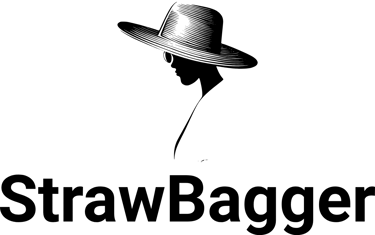Adopt a "strawbagger mindset!"

Cork Fabric
Cork Fabric: Its Benefits and Uses
Cork fabric is derived from the bark of cork oak trees, which can be harvested without harming the tree, making it a renewable and sustainable resource. It's naturally water-resistant, lightweight, and durable.
Source: (The Ethos)
Benefits:
Renewable Resource: Harvesting cork doesn't require cutting down trees, allowing for repeated use.
Biodegradable: Naturally decomposes, reducing environmental waste.
Durable and Lightweight: Ideal for various fashion applications.
Water-Resistant: Naturally repels water, making it suitable for accessories.
Uses:
Accessories like wallets, bags, and shoes.
Fashion items such as hats and belts.
Home décor including placemats and coasters.
Source: (The Ethos)
Let's take a Closer Look at Cork

Cork as a Sustainable Fabric
1. What is Cork Fabric?
Cork fabric, also known as cork leather or vegan leather, is made from the bark of the cork oak tree (Quercus suber), primarily harvested in Portugal and parts of the Mediterranean.
The bark is carefully stripped from living trees — a process that does not harm the tree — and then processed into thin sheets, backed with a fabric (usually cotton or polyester) to create a flexible, durable textile.
Often used as an eco-friendly alternative to leather, cork fabric combines sustainability, unique texture, and water-resistant properties.
2. Environmental Benefits
Renewable Resource: Cork oak trees can be harvested every 9–12 years without damage, and they can live up to 200 years. This makes cork one of the few truly renewable natural materials.
Carbon Sequestration: Harvested cork trees absorb 3–5 times more CO₂ than unharvested ones. Cork oak forests are vital carbon sinks and help combat climate change.
Biodiversity Protection: Cork oak forests support rich biodiversity, providing habitat for endangered species like the Iberian lynx and various native birds and insects.
Minimal Waste: Nearly every part of the cork bark is used — scraps and dust from production are recycled into other cork products or used as biomass for energy.
3. Durability and Longevity
Cork fabric is:
Naturally water-resistant
Scratch-resistant
Stain-resistant
Anti-microbial and hypoallergenic
It is durable enough for everyday items like bags, wallets, and upholstery, often outlasting synthetic alternatives.
With proper care, cork fabric maintains its integrity and aesthetic appeal over many years.
4. Low-Waste Production
The cork fabric manufacturing process is low-impact:
Trees are not cut down
Bark is removed manually using traditional methods
Little to no toxic chemicals are required in raw cork processing
Some cork fabrics are backed with organic cotton or recycled fabrics to improve eco-credentials.
Cork production supports closed-loop principles, as it produces very little waste and many by-products are recyclable or compostable.
5. Versatility and Comfort
Cork fabric is lightweight, flexible, and soft to the touch, making it an ideal alternative to leather or PVC-based materials.
Though primarily used in accessories, cork is increasingly used in:
Footwear
Clothing (jackets, trims, patches)
Interior design (wallpaper, furniture upholstery)
Tech accessories (laptop sleeves, phone cases)
It's vegan, making it suitable for cruelty-free and ethical fashion choices.
Cork also adapts well to printing and dyeing, allowing a range of textures and colors for design versatility.
6. Economic and Social Impact
The cork industry provides vital employment in rural Mediterranean regions, particularly in Portugal, where it supports over 100,000 jobs.
Harvesting cork bark is a specialized skill passed down through generations, helping preserve cultural heritage and support traditional livelihoods.
Sustainably managed cork oak landscapes also help fight desertification and soil erosion, contributing to long-term land stewardship.
7. Circular Fashion and Cork Fabric
Cork is a biodegradable material, especially when used with natural fabric backings like organic cotton or linen.
At end of life, cork items can be:
Recycled into composite cork products
Composted, if free from synthetic backings or finishes
The longevity of cork fabric promotes slow fashion, as high-quality cork goods rarely need frequent replacement.
Its resilience and ease of maintenance also make cork a practical choice for zero-waste lifestyles.
8. Things to Consider
Fabric Backing Matters: While the cork layer is natural, many cork fabrics are backed with polyester or PVC, which compromises sustainability. Look for cork bound to organic cotton or recycled materials.
Cost and Accessibility: Cork fabric can be more expensive than mass-produced synthetics due to labor-intensive harvesting and limited growing regions.
Limited Stretch: Cork has minimal elasticity, which may restrict its use in certain clothing applications.
Traceability: Choose certified cork sources with FSC (Forest Stewardship Council) certification or other eco-labels to ensure responsible harvesting practices.
